Contemporary Debates: UK Health Inequality and Government Approach
VerifiedAdded on 2023/01/05
|9
|2565
|69
Essay
AI Summary
This essay delves into the critical issue of health inequalities within the United Kingdom, examining the disparities in health outcomes across various demographic groups. It begins by defining health inequalities and highlighting their socioeconomic and societal consequences. The main body of the essay explores the multifaceted nature of these inequalities, focusing on factors such as life expectancy, access to healthcare, and the impact of socioeconomic status, biology, and special attributes. The essay then analyzes the government's approaches to address these inequalities, considering policies and strategies aimed at reducing disparities. It also investigates the correlation between mental health, well-being, and physical health, as well as the influence of employment and environmental factors like air pollution. The conclusion summarizes the key findings and emphasizes the importance of recognizing and addressing the dynamic nature of health inequalities to improve public health outcomes.

Contemporary Debates
Paraphrase This Document
Need a fresh take? Get an instant paraphrase of this document with our AI Paraphraser
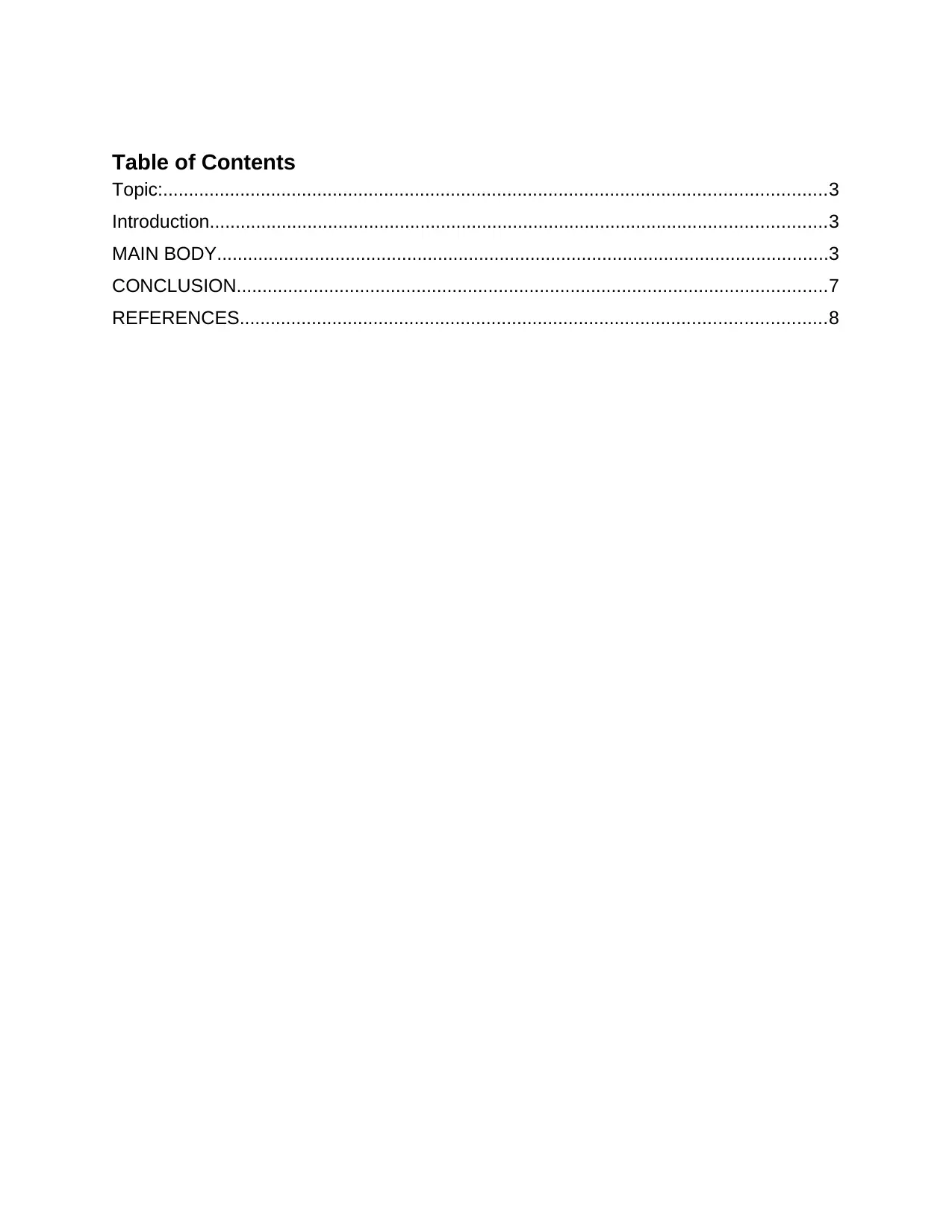
Table of Contents
Topic:.................................................................................................................................3
Introduction........................................................................................................................3
MAIN BODY.......................................................................................................................3
CONCLUSION...................................................................................................................7
REFERENCES..................................................................................................................8
Topic:.................................................................................................................................3
Introduction........................................................................................................................3
MAIN BODY.......................................................................................................................3
CONCLUSION...................................................................................................................7
REFERENCES..................................................................................................................8
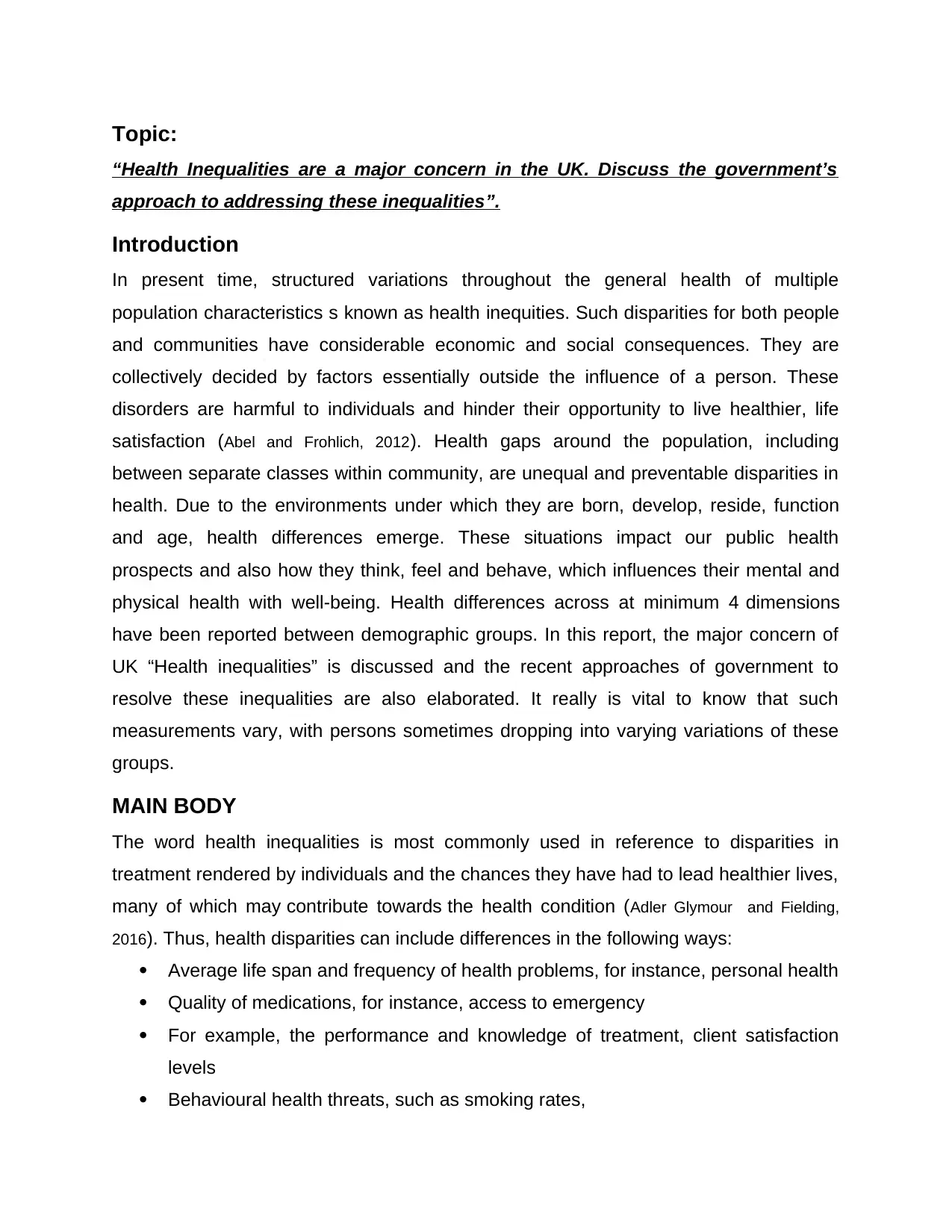
Topic:
“Health Inequalities are a major concern in the UK. Discuss the government’s
approach to addressing these inequalities”.
Introduction
In present time, structured variations throughout the general health of multiple
population characteristics s known as health inequities. Such disparities for both people
and communities have considerable economic and social consequences. They are
collectively decided by factors essentially outside the influence of a person. These
disorders are harmful to individuals and hinder their opportunity to live healthier, life
satisfaction (Abel and Frohlich, 2012). Health gaps around the population, including
between separate classes within community, are unequal and preventable disparities in
health. Due to the environments under which they are born, develop, reside, function
and age, health differences emerge. These situations impact our public health
prospects and also how they think, feel and behave, which influences their mental and
physical health with well-being. Health differences across at minimum 4 dimensions
have been reported between demographic groups. In this report, the major concern of
UK “Health inequalities” is discussed and the recent approaches of government to
resolve these inequalities are also elaborated. It really is vital to know that such
measurements vary, with persons sometimes dropping into varying variations of these
groups.
MAIN BODY
The word health inequalities is most commonly used in reference to disparities in
treatment rendered by individuals and the chances they have had to lead healthier lives,
many of which may contribute towards the health condition (Adler Glymour and Fielding,
2016). Thus, health disparities can include differences in the following ways:
Average life span and frequency of health problems, for instance, personal health
Quality of medications, for instance, access to emergency
For example, the performance and knowledge of treatment, client satisfaction
levels
Behavioural health threats, such as smoking rates,
“Health Inequalities are a major concern in the UK. Discuss the government’s
approach to addressing these inequalities”.
Introduction
In present time, structured variations throughout the general health of multiple
population characteristics s known as health inequities. Such disparities for both people
and communities have considerable economic and social consequences. They are
collectively decided by factors essentially outside the influence of a person. These
disorders are harmful to individuals and hinder their opportunity to live healthier, life
satisfaction (Abel and Frohlich, 2012). Health gaps around the population, including
between separate classes within community, are unequal and preventable disparities in
health. Due to the environments under which they are born, develop, reside, function
and age, health differences emerge. These situations impact our public health
prospects and also how they think, feel and behave, which influences their mental and
physical health with well-being. Health differences across at minimum 4 dimensions
have been reported between demographic groups. In this report, the major concern of
UK “Health inequalities” is discussed and the recent approaches of government to
resolve these inequalities are also elaborated. It really is vital to know that such
measurements vary, with persons sometimes dropping into varying variations of these
groups.
MAIN BODY
The word health inequalities is most commonly used in reference to disparities in
treatment rendered by individuals and the chances they have had to lead healthier lives,
many of which may contribute towards the health condition (Adler Glymour and Fielding,
2016). Thus, health disparities can include differences in the following ways:
Average life span and frequency of health problems, for instance, personal health
Quality of medications, for instance, access to emergency
For example, the performance and knowledge of treatment, client satisfaction
levels
Behavioural health threats, such as smoking rates,
⊘ This is a preview!⊘
Do you want full access?
Subscribe today to unlock all pages.

Trusted by 1+ million students worldwide
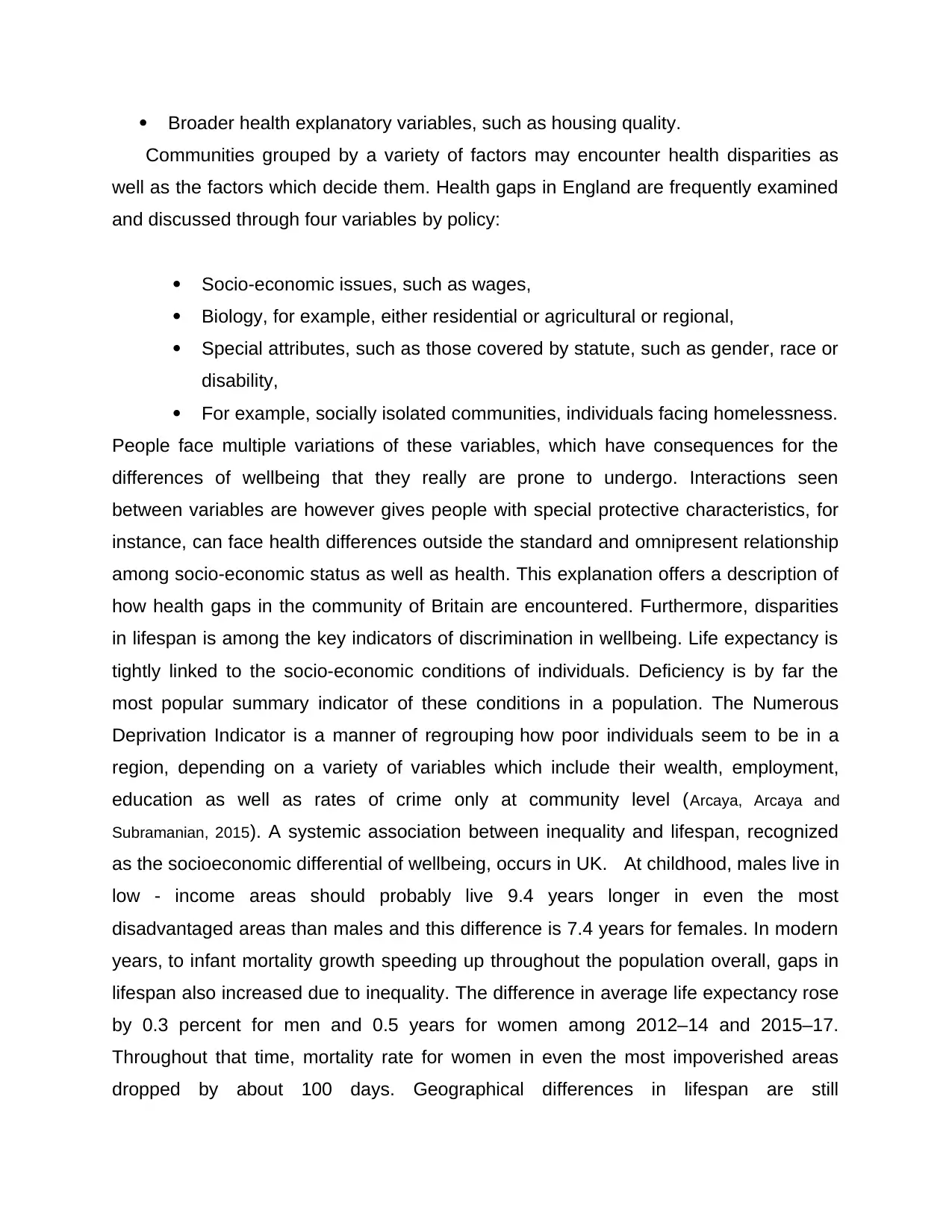
Broader health explanatory variables, such as housing quality.
Communities grouped by a variety of factors may encounter health disparities as
well as the factors which decide them. Health gaps in England are frequently examined
and discussed through four variables by policy:
Socio-economic issues, such as wages,
Biology, for example, either residential or agricultural or regional,
Special attributes, such as those covered by statute, such as gender, race or
disability,
For example, socially isolated communities, individuals facing homelessness.
People face multiple variations of these variables, which have consequences for the
differences of wellbeing that they really are prone to undergo. Interactions seen
between variables are however gives people with special protective characteristics, for
instance, can face health differences outside the standard and omnipresent relationship
among socio-economic status as well as health. This explanation offers a description of
how health gaps in the community of Britain are encountered. Furthermore, disparities
in lifespan is among the key indicators of discrimination in wellbeing. Life expectancy is
tightly linked to the socio-economic conditions of individuals. Deficiency is by far the
most popular summary indicator of these conditions in a population. The Numerous
Deprivation Indicator is a manner of regrouping how poor individuals seem to be in a
region, depending on a variety of variables which include their wealth, employment,
education as well as rates of crime only at community level (Arcaya, Arcaya and
Subramanian, 2015). A systemic association between inequality and lifespan, recognized
as the socioeconomic differential of wellbeing, occurs in UK. At childhood, males live in
low - income areas should probably live 9.4 years longer in even the most
disadvantaged areas than males and this difference is 7.4 years for females. In modern
years, to infant mortality growth speeding up throughout the population overall, gaps in
lifespan also increased due to inequality. The difference in average life expectancy rose
by 0.3 percent for men and 0.5 years for women among 2012–14 and 2015–17.
Throughout that time, mortality rate for women in even the most impoverished areas
dropped by about 100 days. Geographical differences in lifespan are still
Communities grouped by a variety of factors may encounter health disparities as
well as the factors which decide them. Health gaps in England are frequently examined
and discussed through four variables by policy:
Socio-economic issues, such as wages,
Biology, for example, either residential or agricultural or regional,
Special attributes, such as those covered by statute, such as gender, race or
disability,
For example, socially isolated communities, individuals facing homelessness.
People face multiple variations of these variables, which have consequences for the
differences of wellbeing that they really are prone to undergo. Interactions seen
between variables are however gives people with special protective characteristics, for
instance, can face health differences outside the standard and omnipresent relationship
among socio-economic status as well as health. This explanation offers a description of
how health gaps in the community of Britain are encountered. Furthermore, disparities
in lifespan is among the key indicators of discrimination in wellbeing. Life expectancy is
tightly linked to the socio-economic conditions of individuals. Deficiency is by far the
most popular summary indicator of these conditions in a population. The Numerous
Deprivation Indicator is a manner of regrouping how poor individuals seem to be in a
region, depending on a variety of variables which include their wealth, employment,
education as well as rates of crime only at community level (Arcaya, Arcaya and
Subramanian, 2015). A systemic association between inequality and lifespan, recognized
as the socioeconomic differential of wellbeing, occurs in UK. At childhood, males live in
low - income areas should probably live 9.4 years longer in even the most
disadvantaged areas than males and this difference is 7.4 years for females. In modern
years, to infant mortality growth speeding up throughout the population overall, gaps in
lifespan also increased due to inequality. The difference in average life expectancy rose
by 0.3 percent for men and 0.5 years for women among 2012–14 and 2015–17.
Throughout that time, mortality rate for women in even the most impoverished areas
dropped by about 100 days. Geographical differences in lifespan are still
Paraphrase This Document
Need a fresh take? Get an instant paraphrase of this document with our AI Paraphraser
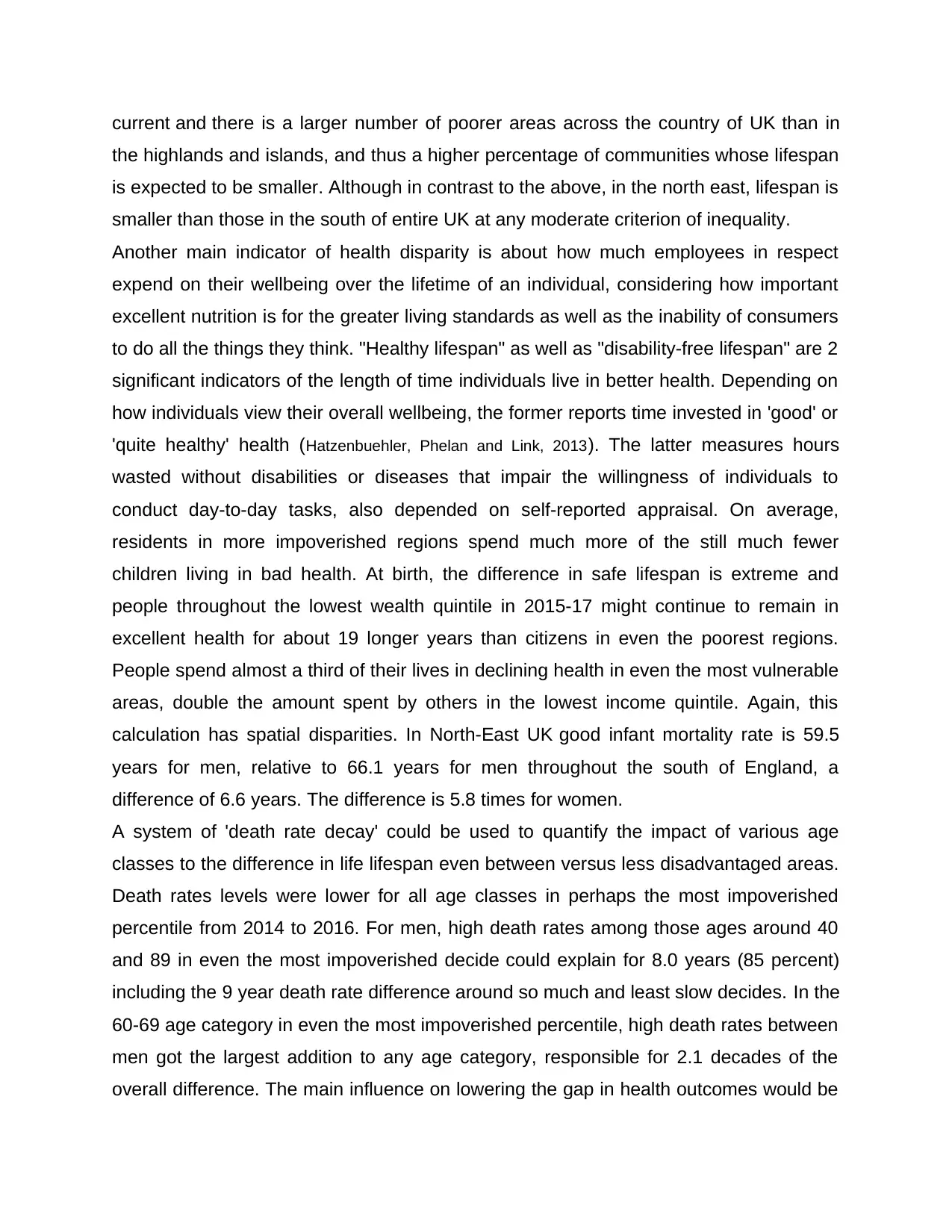
current and there is a larger number of poorer areas across the country of UK than in
the highlands and islands, and thus a higher percentage of communities whose lifespan
is expected to be smaller. Although in contrast to the above, in the north east, lifespan is
smaller than those in the south of entire UK at any moderate criterion of inequality.
Another main indicator of health disparity is about how much employees in respect
expend on their wellbeing over the lifetime of an individual, considering how important
excellent nutrition is for the greater living standards as well as the inability of consumers
to do all the things they think. "Healthy lifespan" as well as "disability-free lifespan" are 2
significant indicators of the length of time individuals live in better health. Depending on
how individuals view their overall wellbeing, the former reports time invested in 'good' or
'quite healthy' health (Hatzenbuehler, Phelan and Link, 2013). The latter measures hours
wasted without disabilities or diseases that impair the willingness of individuals to
conduct day-to-day tasks, also depended on self-reported appraisal. On average,
residents in more impoverished regions spend much more of the still much fewer
children living in bad health. At birth, the difference in safe lifespan is extreme and
people throughout the lowest wealth quintile in 2015-17 might continue to remain in
excellent health for about 19 longer years than citizens in even the poorest regions.
People spend almost a third of their lives in declining health in even the most vulnerable
areas, double the amount spent by others in the lowest income quintile. Again, this
calculation has spatial disparities. In North-East UK good infant mortality rate is 59.5
years for men, relative to 66.1 years for men throughout the south of England, a
difference of 6.6 years. The difference is 5.8 times for women.
A system of 'death rate decay' could be used to quantify the impact of various age
classes to the difference in life lifespan even between versus less disadvantaged areas.
Death rates levels were lower for all age classes in perhaps the most impoverished
percentile from 2014 to 2016. For men, high death rates among those ages around 40
and 89 in even the most impoverished decide could explain for 8.0 years (85 percent)
including the 9 year death rate difference around so much and least slow decides. In the
60-69 age category in even the most impoverished percentile, high death rates between
men got the largest addition to any age category, responsible for 2.1 decades of the
overall difference. The main influence on lowering the gap in health outcomes would be
the highlands and islands, and thus a higher percentage of communities whose lifespan
is expected to be smaller. Although in contrast to the above, in the north east, lifespan is
smaller than those in the south of entire UK at any moderate criterion of inequality.
Another main indicator of health disparity is about how much employees in respect
expend on their wellbeing over the lifetime of an individual, considering how important
excellent nutrition is for the greater living standards as well as the inability of consumers
to do all the things they think. "Healthy lifespan" as well as "disability-free lifespan" are 2
significant indicators of the length of time individuals live in better health. Depending on
how individuals view their overall wellbeing, the former reports time invested in 'good' or
'quite healthy' health (Hatzenbuehler, Phelan and Link, 2013). The latter measures hours
wasted without disabilities or diseases that impair the willingness of individuals to
conduct day-to-day tasks, also depended on self-reported appraisal. On average,
residents in more impoverished regions spend much more of the still much fewer
children living in bad health. At birth, the difference in safe lifespan is extreme and
people throughout the lowest wealth quintile in 2015-17 might continue to remain in
excellent health for about 19 longer years than citizens in even the poorest regions.
People spend almost a third of their lives in declining health in even the most vulnerable
areas, double the amount spent by others in the lowest income quintile. Again, this
calculation has spatial disparities. In North-East UK good infant mortality rate is 59.5
years for men, relative to 66.1 years for men throughout the south of England, a
difference of 6.6 years. The difference is 5.8 times for women.
A system of 'death rate decay' could be used to quantify the impact of various age
classes to the difference in life lifespan even between versus less disadvantaged areas.
Death rates levels were lower for all age classes in perhaps the most impoverished
percentile from 2014 to 2016. For men, high death rates among those ages around 40
and 89 in even the most impoverished decide could explain for 8.0 years (85 percent)
including the 9 year death rate difference around so much and least slow decides. In the
60-69 age category in even the most impoverished percentile, high death rates between
men got the largest addition to any age category, responsible for 2.1 decades of the
overall difference. The main influence on lowering the gap in health outcomes would be
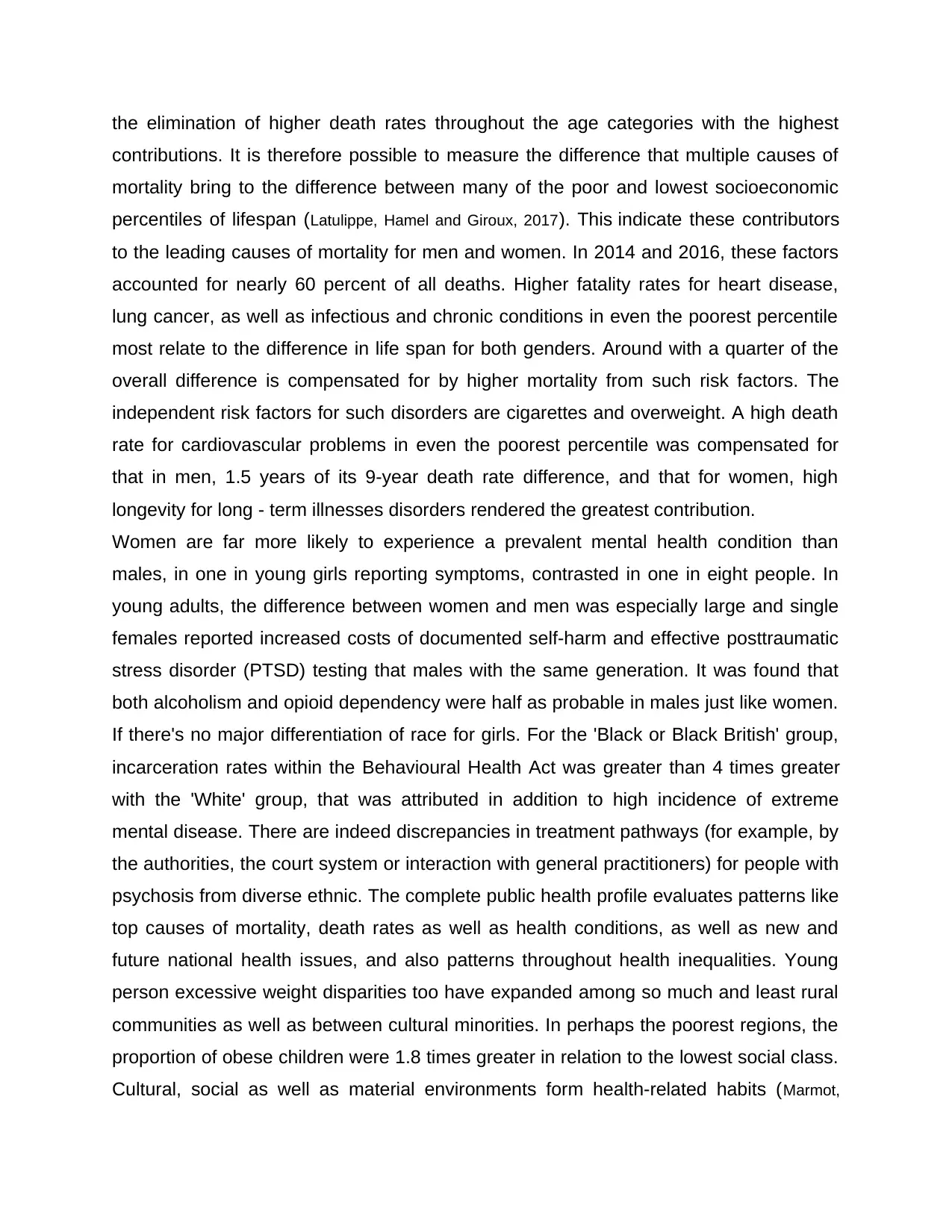
the elimination of higher death rates throughout the age categories with the highest
contributions. It is therefore possible to measure the difference that multiple causes of
mortality bring to the difference between many of the poor and lowest socioeconomic
percentiles of lifespan (Latulippe, Hamel and Giroux, 2017). This indicate these contributors
to the leading causes of mortality for men and women. In 2014 and 2016, these factors
accounted for nearly 60 percent of all deaths. Higher fatality rates for heart disease,
lung cancer, as well as infectious and chronic conditions in even the poorest percentile
most relate to the difference in life span for both genders. Around with a quarter of the
overall difference is compensated for by higher mortality from such risk factors. The
independent risk factors for such disorders are cigarettes and overweight. A high death
rate for cardiovascular problems in even the poorest percentile was compensated for
that in men, 1.5 years of its 9-year death rate difference, and that for women, high
longevity for long - term illnesses disorders rendered the greatest contribution.
Women are far more likely to experience a prevalent mental health condition than
males, in one in young girls reporting symptoms, contrasted in one in eight people. In
young adults, the difference between women and men was especially large and single
females reported increased costs of documented self-harm and effective posttraumatic
stress disorder (PTSD) testing that males with the same generation. It was found that
both alcoholism and opioid dependency were half as probable in males just like women.
If there's no major differentiation of race for girls. For the 'Black or Black British' group,
incarceration rates within the Behavioural Health Act was greater than 4 times greater
with the 'White' group, that was attributed in addition to high incidence of extreme
mental disease. There are indeed discrepancies in treatment pathways (for example, by
the authorities, the court system or interaction with general practitioners) for people with
psychosis from diverse ethnic. The complete public health profile evaluates patterns like
top causes of mortality, death rates as well as health conditions, as well as new and
future national health issues, and also patterns throughout health inequalities. Young
person excessive weight disparities too have expanded among so much and least rural
communities as well as between cultural minorities. In perhaps the poorest regions, the
proportion of obese children were 1.8 times greater in relation to the lowest social class.
Cultural, social as well as material environments form health-related habits (Marmot,
contributions. It is therefore possible to measure the difference that multiple causes of
mortality bring to the difference between many of the poor and lowest socioeconomic
percentiles of lifespan (Latulippe, Hamel and Giroux, 2017). This indicate these contributors
to the leading causes of mortality for men and women. In 2014 and 2016, these factors
accounted for nearly 60 percent of all deaths. Higher fatality rates for heart disease,
lung cancer, as well as infectious and chronic conditions in even the poorest percentile
most relate to the difference in life span for both genders. Around with a quarter of the
overall difference is compensated for by higher mortality from such risk factors. The
independent risk factors for such disorders are cigarettes and overweight. A high death
rate for cardiovascular problems in even the poorest percentile was compensated for
that in men, 1.5 years of its 9-year death rate difference, and that for women, high
longevity for long - term illnesses disorders rendered the greatest contribution.
Women are far more likely to experience a prevalent mental health condition than
males, in one in young girls reporting symptoms, contrasted in one in eight people. In
young adults, the difference between women and men was especially large and single
females reported increased costs of documented self-harm and effective posttraumatic
stress disorder (PTSD) testing that males with the same generation. It was found that
both alcoholism and opioid dependency were half as probable in males just like women.
If there's no major differentiation of race for girls. For the 'Black or Black British' group,
incarceration rates within the Behavioural Health Act was greater than 4 times greater
with the 'White' group, that was attributed in addition to high incidence of extreme
mental disease. There are indeed discrepancies in treatment pathways (for example, by
the authorities, the court system or interaction with general practitioners) for people with
psychosis from diverse ethnic. The complete public health profile evaluates patterns like
top causes of mortality, death rates as well as health conditions, as well as new and
future national health issues, and also patterns throughout health inequalities. Young
person excessive weight disparities too have expanded among so much and least rural
communities as well as between cultural minorities. In perhaps the poorest regions, the
proportion of obese children were 1.8 times greater in relation to the lowest social class.
Cultural, social as well as material environments form health-related habits (Marmot,
⊘ This is a preview!⊘
Do you want full access?
Subscribe today to unlock all pages.

Trusted by 1+ million students worldwide
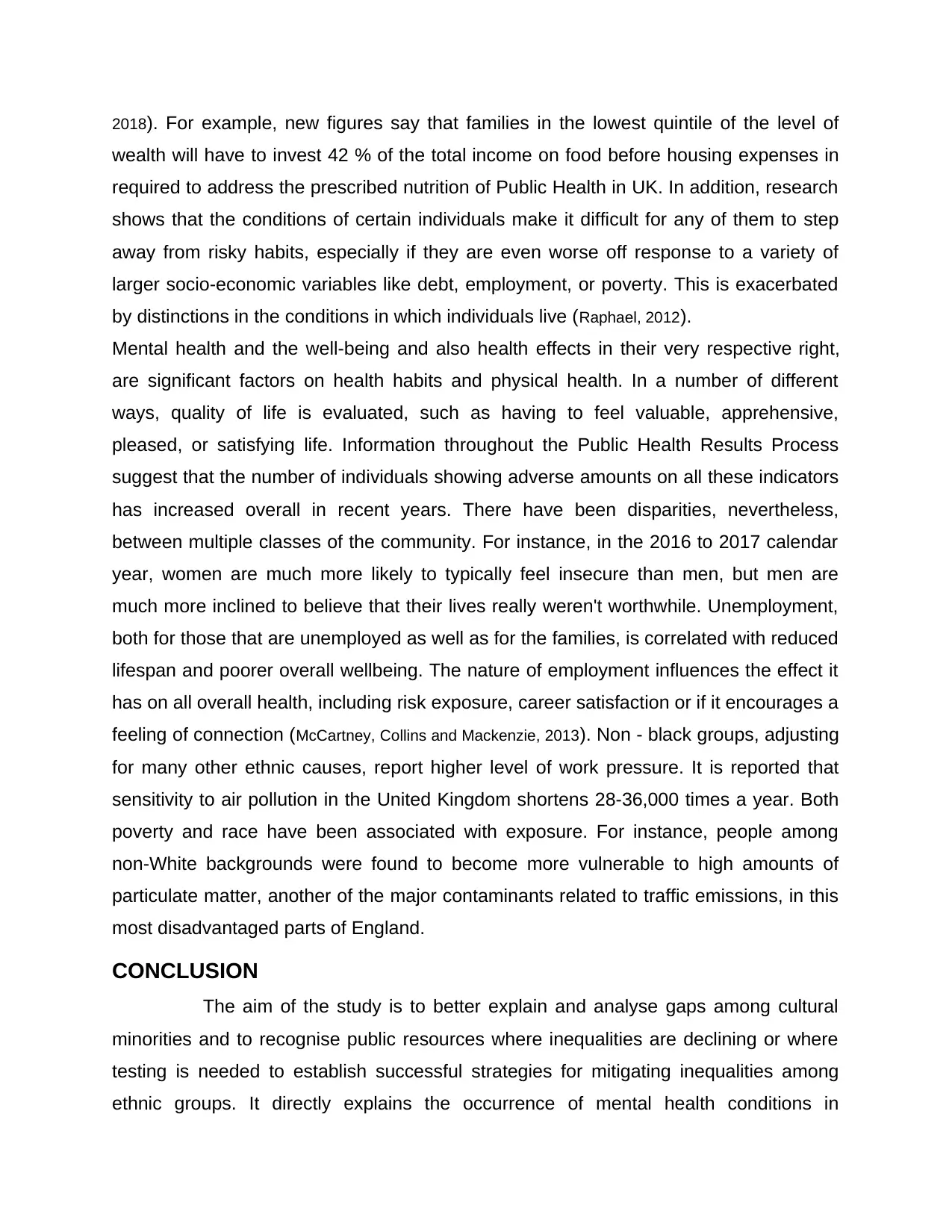
2018). For example, new figures say that families in the lowest quintile of the level of
wealth will have to invest 42 % of the total income on food before housing expenses in
required to address the prescribed nutrition of Public Health in UK. In addition, research
shows that the conditions of certain individuals make it difficult for any of them to step
away from risky habits, especially if they are even worse off response to a variety of
larger socio-economic variables like debt, employment, or poverty. This is exacerbated
by distinctions in the conditions in which individuals live (Raphael, 2012).
Mental health and the well-being and also health effects in their very respective right,
are significant factors on health habits and physical health. In a number of different
ways, quality of life is evaluated, such as having to feel valuable, apprehensive,
pleased, or satisfying life. Information throughout the Public Health Results Process
suggest that the number of individuals showing adverse amounts on all these indicators
has increased overall in recent years. There have been disparities, nevertheless,
between multiple classes of the community. For instance, in the 2016 to 2017 calendar
year, women are much more likely to typically feel insecure than men, but men are
much more inclined to believe that their lives really weren't worthwhile. Unemployment,
both for those that are unemployed as well as for the families, is correlated with reduced
lifespan and poorer overall wellbeing. The nature of employment influences the effect it
has on all overall health, including risk exposure, career satisfaction or if it encourages a
feeling of connection (McCartney, Collins and Mackenzie, 2013). Non - black groups, adjusting
for many other ethnic causes, report higher level of work pressure. It is reported that
sensitivity to air pollution in the United Kingdom shortens 28-36,000 times a year. Both
poverty and race have been associated with exposure. For instance, people among
non-White backgrounds were found to become more vulnerable to high amounts of
particulate matter, another of the major contaminants related to traffic emissions, in this
most disadvantaged parts of England.
CONCLUSION
The aim of the study is to better explain and analyse gaps among cultural
minorities and to recognise public resources where inequalities are declining or where
testing is needed to establish successful strategies for mitigating inequalities among
ethnic groups. It directly explains the occurrence of mental health conditions in
wealth will have to invest 42 % of the total income on food before housing expenses in
required to address the prescribed nutrition of Public Health in UK. In addition, research
shows that the conditions of certain individuals make it difficult for any of them to step
away from risky habits, especially if they are even worse off response to a variety of
larger socio-economic variables like debt, employment, or poverty. This is exacerbated
by distinctions in the conditions in which individuals live (Raphael, 2012).
Mental health and the well-being and also health effects in their very respective right,
are significant factors on health habits and physical health. In a number of different
ways, quality of life is evaluated, such as having to feel valuable, apprehensive,
pleased, or satisfying life. Information throughout the Public Health Results Process
suggest that the number of individuals showing adverse amounts on all these indicators
has increased overall in recent years. There have been disparities, nevertheless,
between multiple classes of the community. For instance, in the 2016 to 2017 calendar
year, women are much more likely to typically feel insecure than men, but men are
much more inclined to believe that their lives really weren't worthwhile. Unemployment,
both for those that are unemployed as well as for the families, is correlated with reduced
lifespan and poorer overall wellbeing. The nature of employment influences the effect it
has on all overall health, including risk exposure, career satisfaction or if it encourages a
feeling of connection (McCartney, Collins and Mackenzie, 2013). Non - black groups, adjusting
for many other ethnic causes, report higher level of work pressure. It is reported that
sensitivity to air pollution in the United Kingdom shortens 28-36,000 times a year. Both
poverty and race have been associated with exposure. For instance, people among
non-White backgrounds were found to become more vulnerable to high amounts of
particulate matter, another of the major contaminants related to traffic emissions, in this
most disadvantaged parts of England.
CONCLUSION
The aim of the study is to better explain and analyse gaps among cultural
minorities and to recognise public resources where inequalities are declining or where
testing is needed to establish successful strategies for mitigating inequalities among
ethnic groups. It directly explains the occurrence of mental health conditions in
Paraphrase This Document
Need a fresh take? Get an instant paraphrase of this document with our AI Paraphraser
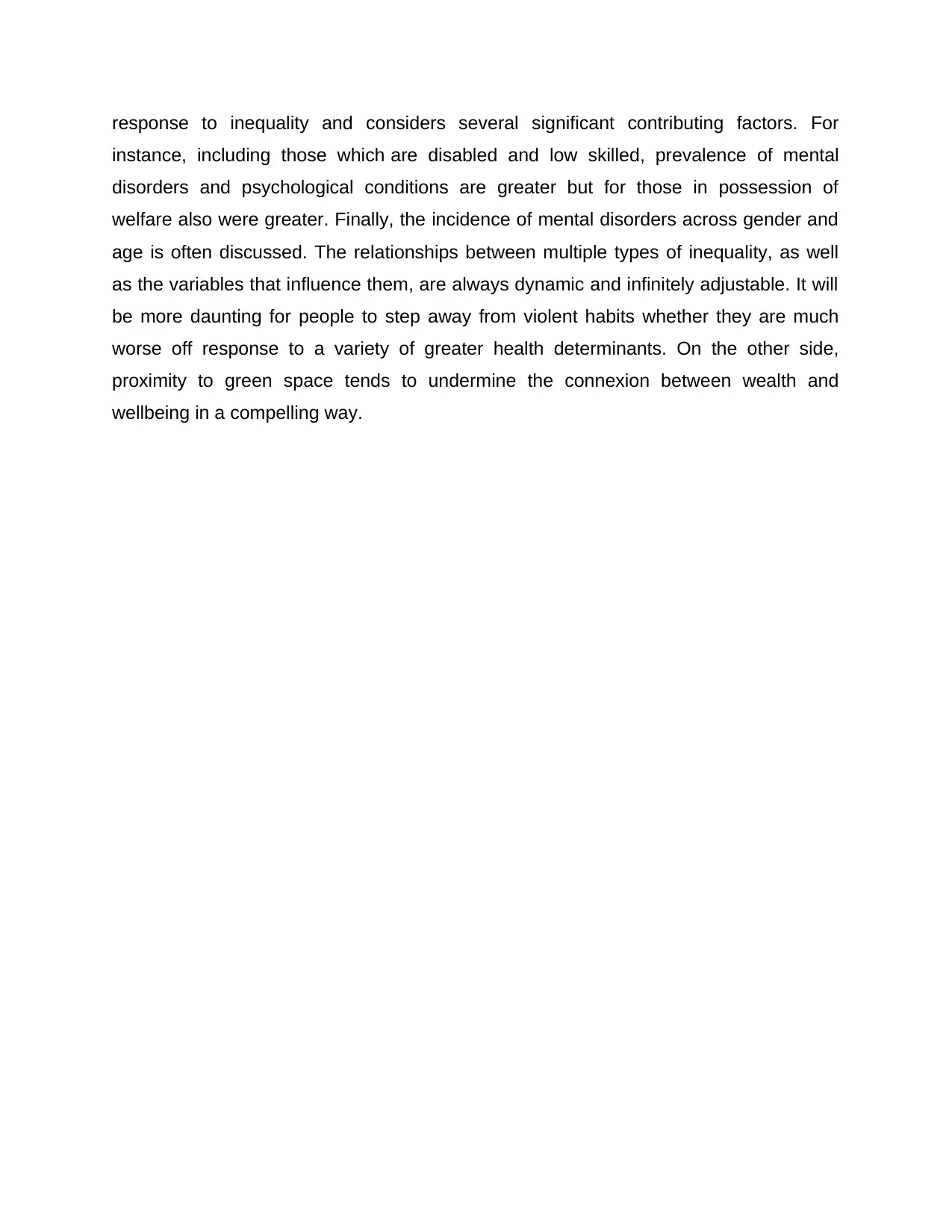
response to inequality and considers several significant contributing factors. For
instance, including those which are disabled and low skilled, prevalence of mental
disorders and psychological conditions are greater but for those in possession of
welfare also were greater. Finally, the incidence of mental disorders across gender and
age is often discussed. The relationships between multiple types of inequality, as well
as the variables that influence them, are always dynamic and infinitely adjustable. It will
be more daunting for people to step away from violent habits whether they are much
worse off response to a variety of greater health determinants. On the other side,
proximity to green space tends to undermine the connexion between wealth and
wellbeing in a compelling way.
instance, including those which are disabled and low skilled, prevalence of mental
disorders and psychological conditions are greater but for those in possession of
welfare also were greater. Finally, the incidence of mental disorders across gender and
age is often discussed. The relationships between multiple types of inequality, as well
as the variables that influence them, are always dynamic and infinitely adjustable. It will
be more daunting for people to step away from violent habits whether they are much
worse off response to a variety of greater health determinants. On the other side,
proximity to green space tends to undermine the connexion between wealth and
wellbeing in a compelling way.
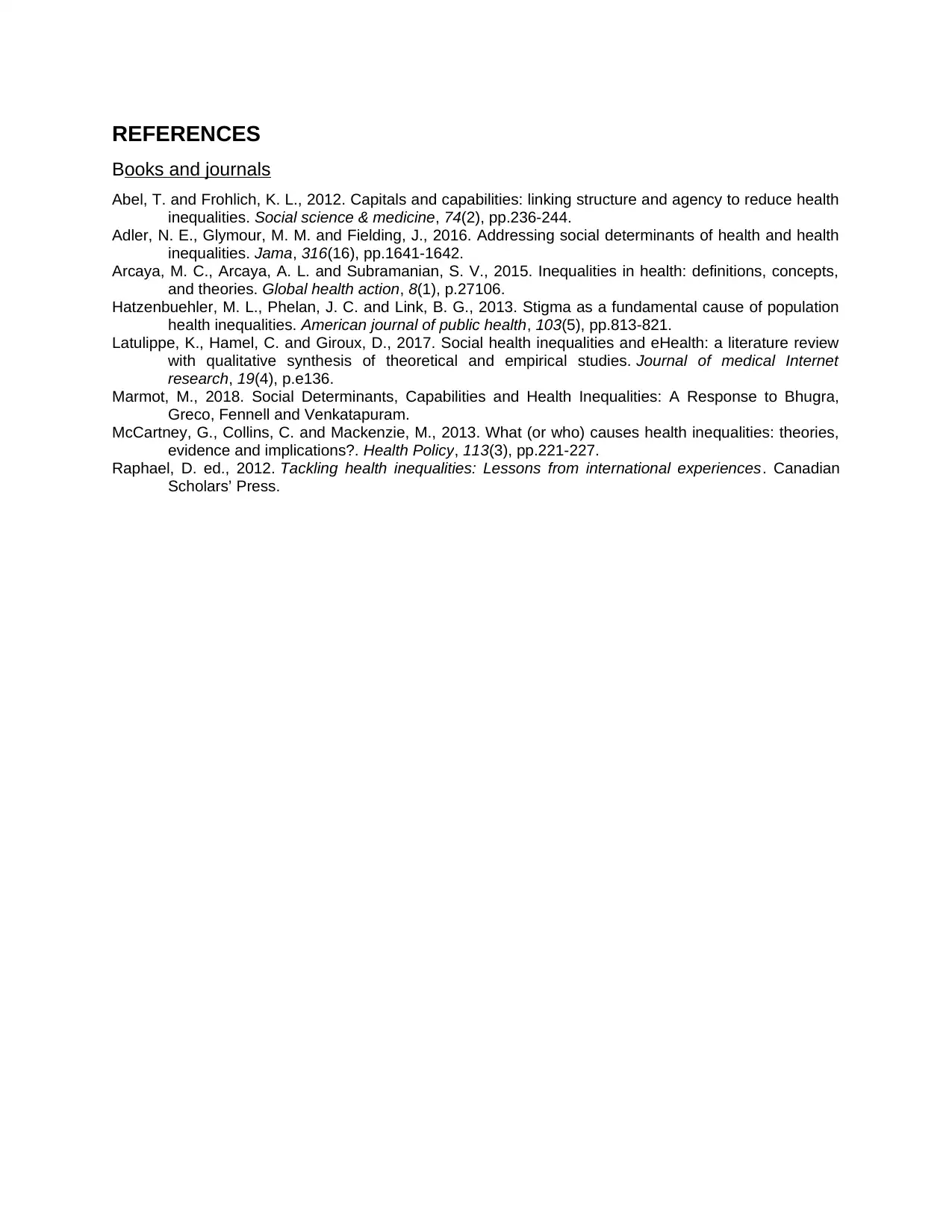
REFERENCES
Books and journals
Abel, T. and Frohlich, K. L., 2012. Capitals and capabilities: linking structure and agency to reduce health
inequalities. Social science & medicine, 74(2), pp.236-244.
Adler, N. E., Glymour, M. M. and Fielding, J., 2016. Addressing social determinants of health and health
inequalities. Jama, 316(16), pp.1641-1642.
Arcaya, M. C., Arcaya, A. L. and Subramanian, S. V., 2015. Inequalities in health: definitions, concepts,
and theories. Global health action, 8(1), p.27106.
Hatzenbuehler, M. L., Phelan, J. C. and Link, B. G., 2013. Stigma as a fundamental cause of population
health inequalities. American journal of public health, 103(5), pp.813-821.
Latulippe, K., Hamel, C. and Giroux, D., 2017. Social health inequalities and eHealth: a literature review
with qualitative synthesis of theoretical and empirical studies. Journal of medical Internet
research, 19(4), p.e136.
Marmot, M., 2018. Social Determinants, Capabilities and Health Inequalities: A Response to Bhugra,
Greco, Fennell and Venkatapuram.
McCartney, G., Collins, C. and Mackenzie, M., 2013. What (or who) causes health inequalities: theories,
evidence and implications?. Health Policy, 113(3), pp.221-227.
Raphael, D. ed., 2012. Tackling health inequalities: Lessons from international experiences. Canadian
Scholars’ Press.
Books and journals
Abel, T. and Frohlich, K. L., 2012. Capitals and capabilities: linking structure and agency to reduce health
inequalities. Social science & medicine, 74(2), pp.236-244.
Adler, N. E., Glymour, M. M. and Fielding, J., 2016. Addressing social determinants of health and health
inequalities. Jama, 316(16), pp.1641-1642.
Arcaya, M. C., Arcaya, A. L. and Subramanian, S. V., 2015. Inequalities in health: definitions, concepts,
and theories. Global health action, 8(1), p.27106.
Hatzenbuehler, M. L., Phelan, J. C. and Link, B. G., 2013. Stigma as a fundamental cause of population
health inequalities. American journal of public health, 103(5), pp.813-821.
Latulippe, K., Hamel, C. and Giroux, D., 2017. Social health inequalities and eHealth: a literature review
with qualitative synthesis of theoretical and empirical studies. Journal of medical Internet
research, 19(4), p.e136.
Marmot, M., 2018. Social Determinants, Capabilities and Health Inequalities: A Response to Bhugra,
Greco, Fennell and Venkatapuram.
McCartney, G., Collins, C. and Mackenzie, M., 2013. What (or who) causes health inequalities: theories,
evidence and implications?. Health Policy, 113(3), pp.221-227.
Raphael, D. ed., 2012. Tackling health inequalities: Lessons from international experiences. Canadian
Scholars’ Press.
⊘ This is a preview!⊘
Do you want full access?
Subscribe today to unlock all pages.

Trusted by 1+ million students worldwide
1 out of 9
Related Documents
Your All-in-One AI-Powered Toolkit for Academic Success.
+13062052269
info@desklib.com
Available 24*7 on WhatsApp / Email
![[object Object]](/_next/static/media/star-bottom.7253800d.svg)
Unlock your academic potential
Copyright © 2020–2025 A2Z Services. All Rights Reserved. Developed and managed by ZUCOL.





